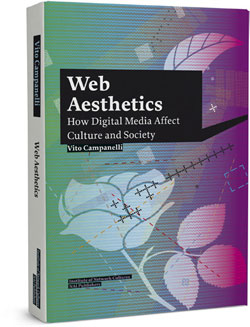Vito Campanelli, Web Aesthetics: How Digital Media Affect Culture and Society, NAi Publishers, Rotterdam and the Institute of Network Cultures, Amsterdam, 2010. ISBN 978-90-5662-770-6.

On Friday, March 11th at 17:00 during Video Vortex #6, the INC is pleased to present Web Aesthetics: How Digital Media Affect Culture and Society by author Vito Campanelli.
During the launch Vito Campanelli will introduce the public to Web Aesthetics.
As the most recent publication in the INC’s Studies in Network Cultures Series, Web Aesthetics explores how online video, Web interfaces, file sharing, mailing lists and social networks are transforming our experience of the world. While the social dimension of these Web-related forms dominates public discourse, their aesthetic impact is largely ignored. In response, Web Aesthetics intervenes in the field of new media studies and art theory, proposing an organic theory of digital media aesthetics.
Check out this great review found in the most recent issue of Neural magazine (online and in print):
Re-posted from Neural magazine online:
“The aesthetics of networks and the web, approached from the most acknowledged definition of aesthetics, is an underdeveloped field despite more than a decade of web design and hundreds of web-based artworks. What can be called “Web Aesthetics” is the main research focus of Vito Campanelli (media theorist and Neural contributor), who analyzed the web and its role since the beginning. The pervasiveness of what he calls “web-related forms” is taken as the main territory from which to start and to come back to after every digression based on social, political, historical, and aesthetic speculations. Campanelli argues that the net art movement has introduced new and confrontational aesthetic canons, but he valuably connects a variety of different concepts like (just to name a few) the importance of dialogue with memes, the optical and haptic experience of the web (explained through web-based art), the Aby Warburg’s “engram” and the “remix”. These fluid connections are sometimes intertwined with fascinating parallels, like the one between the space of contemporary frequent flying and moving in airports and the kind of “travel” we do in peer-to-peer networks. Campanelli winds his theoretical path through plenty of philosophical ideas, finally building something that is properly aesthetic. And his commitment to analyze digital media with a philosophy of aesthetic language is impressive, as is the amount of research involved – very visible through the abundance of quotes – that makes this text a pivotal one.”


